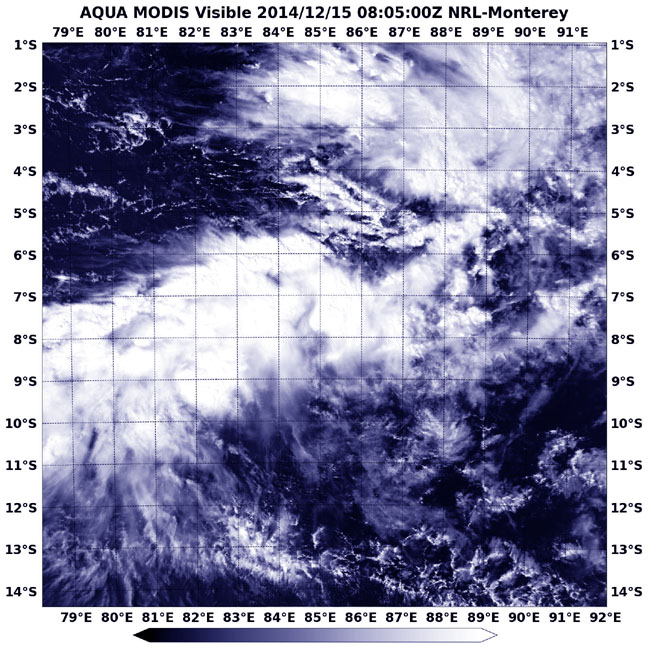NASA Catches Tropical Cyclone Bakung's Remnants

NASA's Aqua satellite captured this image of the remnants of Tropical Cyclone Bakung on Dec. 15 at 08:05 UTC (3:05 a.m. EST). Image Credit: NASA/NRL
The Moderate Resolution Imaging Spectroradiometer or MODIS instrument that flies aboard Aqua captured a visible picture of Bakung's elongated remnants on Dec. 5 at 08:05 UTC (3:05 a.m. EST). The storm appeared to be stretched out from west to east in the visible image.
The last advisory on the tropical cyclone came on Dec. 13 when the storm was still a tropical storm with maximum sustained winds near 35 knots (40 mph/62 kph), but weakening.
Bakung was located near 9.1 south longitude and 89.6 east latitude or about 466 nautical miles (536 miles/863 km) west-northwest of Cocos Islands. It was still moving to the west-northwest at 8 knots (9.2 mph/14.8 kph).
By Dec. 15 the remnants still showed some low-level circulation but it was poorly defined. Bakung's remnant low pressure area was centered near 9.6 south longitude and 85.5 east latitude, 690 nautical miles (794 miles/1,278 km) west of Cocos Island.
Forecasters at the Joint Typhoon Warning Center (JTWC) noted that an analysis of the upper-level of the troposphere (the layer of atmosphere closest to Earth where weather occurs) showed unfavorable conditions with vertical wind shear blowing as strong as 30 to 40 knots (34 mph/55 kph to 46 mph/74 kph).
The JTWC gives Bakung a low chance of redeveloping in the next day.
Rob Gutro
NASA's Goddard Space Flight Center
Media Contact
More Information:
http://www.nasa.gov/content/goddard/bakung-southern-indian-ocean/All latest news from the category: Earth Sciences
Earth Sciences (also referred to as Geosciences), which deals with basic issues surrounding our planet, plays a vital role in the area of energy and raw materials supply.
Earth Sciences comprises subjects such as geology, geography, geological informatics, paleontology, mineralogy, petrography, crystallography, geophysics, geodesy, glaciology, cartography, photogrammetry, meteorology and seismology, early-warning systems, earthquake research and polar research.
Newest articles

A ‘language’ for ML models to predict nanopore properties
A large number of 2D materials like graphene can have nanopores – small holes formed by missing atoms through which foreign substances can pass. The properties of these nanopores dictate many…

Clinically validated, wearable ultrasound patch
… for continuous blood pressure monitoring. A team of researchers at the University of California San Diego has developed a new and improved wearable ultrasound patch for continuous and noninvasive…

A new puzzle piece for string theory research
Dr. Ksenia Fedosova from the Cluster of Excellence Mathematics Münster, along with an international research team, has proven a conjecture in string theory that physicists had proposed regarding certain equations….



